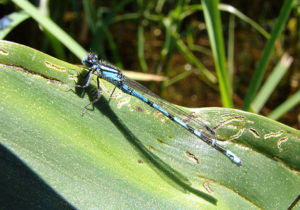Thanks to a generous grant from the Sarah de Coizart Trust, NH Audubon launched a multi-state damselfly project this summer (2018). The project focuses on four species of bluets (New England, Little, Scarlet, and Pine Barrens) that are largely endemic to the region from New Jersey to Maine, and which are often considered rare in states where they occur.

The project has three main goals, the first of which is to update our information on where each species occurs across the region. At this stage in the project, we are also particularly interested in updating older records – usually over 20 years old. In June, staff and volunteers from NH Audubon and our partners started looking for two early-emerging species, with a focus on sites in NJ, RI, MA, NH, and ME. While results from other states are not immediately available, I can report that at least 25 ponds have been visited here in the Granite State, and at least one of the target species has been found at all but seven of them.
For the New England Bluet, there are 16 sites where our data is at least 20 years old, and seven of these were visited in the last month. The target critter was found at four of these, while at the same time being “discovered” at five new sites, suggesting that the species remains widespread. The other early species – Pine Barrens Bluet – is known from only one site in NH (that we know of!), and a search there in mid-June failed to detect it. This doesn’t mean it’s not there, and we plan to try again in 2019, when we’ll also intend to visit the remaining key sites for New England Bluet. In the meantime, we’re gearing up for Little Bluet and Scarlet Bluet, which emerge in late June and fly through early August. A few of each have already been found by observers searching for the early species.
When all the data have been collected for all four species region-wide, we also intend to create habitat models for each, and finally draft a conservation plan that describes habitat needs, population status, potential threats, and conservation actions that benefit these endemics. Stay tuned for updates on all these components of the project as our work continues.
Pamela D. Hunt, Ph.D.
Avian Conservation Biologist
